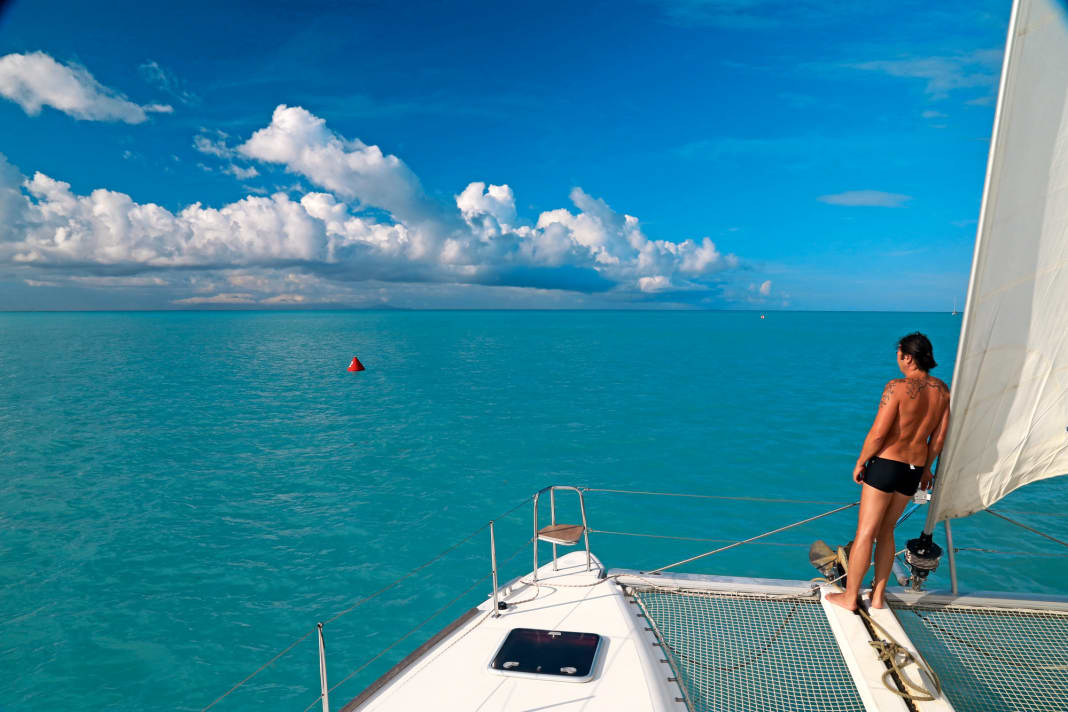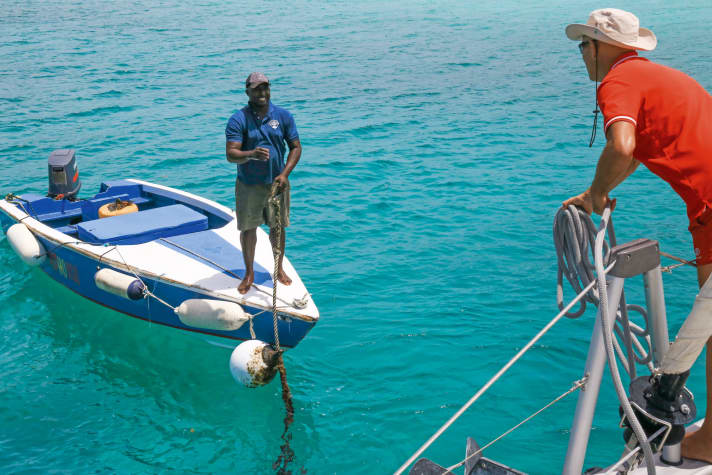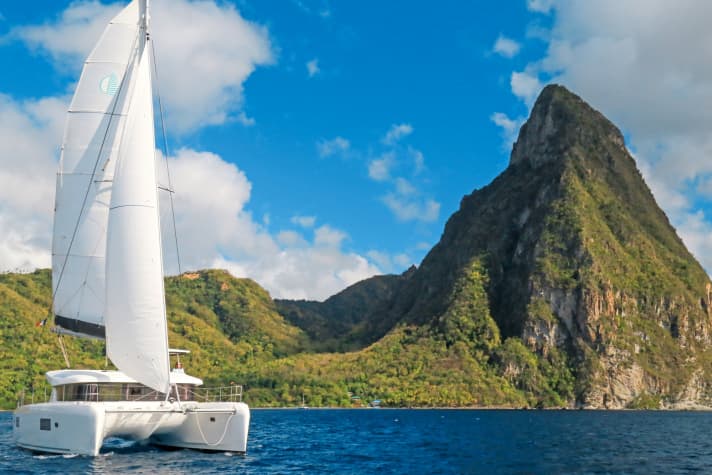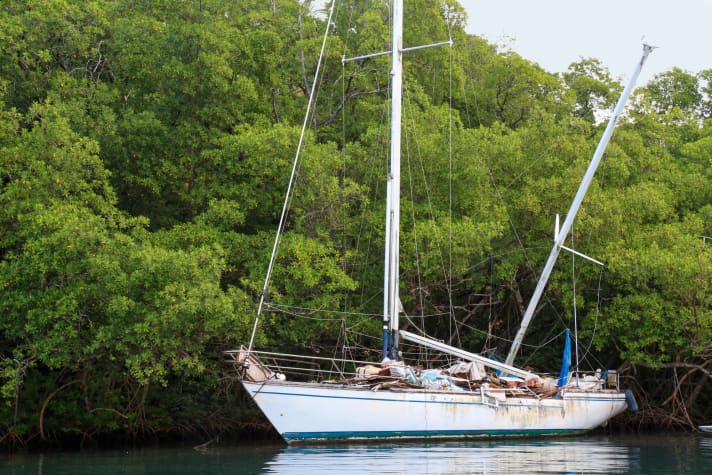





Seamanship
Many areas are poorly buoyed or hardly buoyed at all. Crews must also remember that fairways in the Caribbean are buoyed the other way round than in Europe: when entering from the sea, the red buoys are to starboard, not the green ones. It is also important to navigate by eyeball, i.e. by sight, which is mainly to do with the often reef-strewn bottom. This is because the coral heads have to be navigated around when entering secluded bays. The best way to do this is with one or two crew members at the bow. Ideally, they should be equipped with polarised sunglasses, as these block out the sun's reflections from the water and provide better visibility.
Important: Don't approach a complicated anchorage late in the afternoon against the light, then it is difficult to recognise anything. The sun sets very quickly in the Caribbean in the evening. It is advisable to be moored by 4 pm at the latest. The spotters on the bow look for dark spots in the turquoise-coloured water, which usually indicate a reef. If there are still about two metres of water above it, it still shimmers brown-green; if it becomes shallower, the colour changes to brown-yellow.
A brief portrait of Caribbean destinations:
Anchoring
... on corals! Firstly, this destroys the reef, and secondly, the anchor either doesn't hold there at all or it can get badly snagged. So look for a sandy bottom. In many areas, mooring buoys are also laid out to protect the corals and seagrass beds - where the turtles like to graze. These are often subject to a charge. A cashier usually comes by dinghy, sometimes you also have to pay at the beach bar. Important: The basic weights are not always reliable. In the French areas or the British Virgin Islands, the murings are often professional; elsewhere, an old engine block or a fence post is sometimes used instead of a bottom weight.
Happy hour and rum tasting
A beach bar with a rum cocktail and reggae playing in the background is simply part of a Caribbean cruise. Sundowners are often half price in many bars at happy hour from 4 or 5 pm! Famous parties are also organised in some areas, such as the full moon parties on Tortola in Trellis Bay or the legendary Sunday steel band and reggae parties with live music and barbecues on Shirley Heights mountain on Antigua. Especially on the French islands of Guadeloupe or Martinique, but also on other islands, you should visit a rum distillery and take part in a tasting. Here you can experience the differences between rum made from fresh sugar cane juice and rum made from molasses. The tourist boards of the islands have the addresses.
Boat Boys

Particularly in the Windwards and other parts of the Caribbean, where the local population has very little income, it is common for the crew to encounter small motorboats with so-called boat boys waving wildly as they approach a bay, offering their services: For example, guiding those coming in to the free buoy and pulling the lines through, organising shore excursions, selling fruit, fresh bread, T-shirts or home-made jewellery - there is hardly anything that is not on the programme. Sometimes several boats compete with each other, which can be confusing for skippers.
Those who make use of the services are occasionally in for a surprise, because they want to be paid, and some boat boys charge astonishingly high sums of 10 or 20 US dollars. The buoy fee is sometimes added to this. Negotiating can help in this case, but it doesn't have to. And the tone can be quite rough. The dealers, on the other hand, are usually very sociable. Tip: Always remain friendly and polite, even if you refuse a service or the dealer is pushy, then there are actually no problems.
Tours to diving spots are also sometimes offered. Equipment can then be hired. A good alternative is to snorkel on site. Turtles can almost always be spotted. Tip: Bring your own masks, fins and snorkel, as the on-board equipment that is usually available rarely fits well, or it has been stored next to the outboard motor tank in the cockpit or is unhygienic.
Night driving needs to be planned!
What is unusual for skippers is that sailing in the dark is often generally prohibited in the Caribbean for insurance reasons and because of the reef heads. So if you want to make a long crossing to an island at night, you have to obtain prior authorisation from the fleet operator and its insurance company - before the start of the trip. The extent of sailing experience must be verified in a questionnaire. Once the authorisation has been granted, it usually contains clauses that must be observed, such as that the coast beyond a certain depth line may only be sailed after sunrise. Nevertheless, a night sail in the Caribbean is unforgettable - little light between the islands, great starry skies, T-shirt conditions and a gentle trade wind.
Estimate annoying paperwork
For Europeans, the process of clearing in and out is often unfamiliar and surprising. As many of the islands are independent states, a simple change to an island just a few miles away usually requires a bit of bureaucracy: clearing out at immigration or passport police and customs, sometimes also at the marina. On the next island, be sure to call at a port of entry and go through the same procedures again. Information on the procedure and where the offices are located and when they are open can be found in the area guide and often also in the information folders of the charter companies. In some areas, this can take an hour or two. The skipper has to set off with the boat's papers and the crew's passports and fill out various forms. Meanwhile, the crew are not allowed to leave the boat.
Such formalities are not necessary between French islands, in the BVIs and the Bahamas. But: if you only stop on islands for one or two days, you can clear in and out at the same time! An advantage on French islands: There, Europeans have the option of simply doing everything at once at certain places, often shops or marina offices. The skipper simply enters the data himself on a computer. It is helpful to have a crew list with names, place of residence, date and place of birth and passport number with you to speed things up.
Crime and security

It is a topic that is often minimised, but is important for some areas: some parts of the Caribbean are more affected by crime than northern Europeans are used to. It should not be forgotten that the income of locals on some islands is on a par with that of developing countries. You should therefore make it difficult for opportunist thieves, i.e. do not leave valuables in plain sight and lock the boat when you leave it.
Very important: Dinghies are by far the most sought-after stolen goods in the Caribbean. During shore excursions, it is best to connect the dinghy to the dock together with the engine and fuel tank! Long steel cables and locks are available on the charter yacht for this purpose. At night, be sure to pick up the dinghy at Kats in the Davids, stow it on deck at Monos and connect the engine. What is more difficult is that there are some places in the Caribbean where yachts at anchor are sometimes broken into and even attacked with crew on board. However, such attacks are very rare. However, there have also been armed robberies in the last two years while the sailors were asleep on board. Hotspots are one or two bays on the west side of St Lucia and some on the south coast of St Vincent (Kingstown). You should therefore not avoid these islands in general, there are always marinas and bays where it is very safe.
Tip: Check the website of the Caribbean Safety and Security Net before your trip ( safetyandsecuritynet.org ). There is an animated map on which the recent attacks are archived and their exact location is indicated. Charter crews should consistently avoid these locations. The perpetrators often only act locally. When leaving the starting harbour, ask the base manager if he has any safety tips or advises against certain places. Such tips are often included in the fleet's sailing documents anyway.
No currency exchange
In parts of the Caribbean (e.g. St Vincent and the Grenadines, St Lucia, Anguilla, Antigua), the Eastern Caribbean dollar is officially used as a means of payment. Crews can safely ignore this, as almost all services, restaurants and bars in the yachting scene prefer the US dollar or do not accept the Caribbean dollar at all. Therefore, withdraw or change as little of the unloved currency as possible, as it often remains unused. Although card payment is particularly common on American and European-influenced islands and is generally on the rise, you can't rely on it on small islands.
Smartphone trap
Sailors used to the harmonised roaming regulations in Europe are often surprised when they hear that this does not apply in large parts of the Caribbean. The independent island states often have high roaming charges, or there is no network at all. The solution is to either ask the charter company for a mobile wi-fi hotspot for the boat for a fee or to use the sometimes very slow wi-fi in bars or restaurants. The French and Dutch islands are an exception: European roaming law applies there just like at home.
Securing deposits

Anyone chartering in the Caribbean will hopefully stumble across the relatively high deposit amounts when signing the contract. Due to the area and because there are many large catamarans on the move, these are often well above the European level - €6,000 and more is not uncommon. With such risks, a crew would be well advised to think about deposit insurance in good time. This is often offered by the fleet operator itself, but is usually significantly more expensive than with standard insurers.

